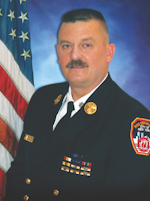Fireground Radio Rules: How to Sharpen Your Skills
I’ve talked about fire radios before, but some of the issues and ideas revolving around radio usage in the fire service continue to evolve and resurface. Let’s look at some important ideas and suggestions related to our fire radios.
The first and most vital issue is just who should be equipped with a radio on the fireground. The answer is simple and, as far as I’m concerned, not debatable – everyone! Every single firefighter should be radio equipped. I know there are chiefs out there who come up with reasons for not doing this, but they are wrong. It is inconceivable that any firefighter would be allowed to enter the dangerous and deadly conditions inside a burning building without reliable two-way communications. Even a firefighter who is part of a two- or three-person inside team could end up alone and in distress.
The “change-channel” syndrome
The next radio topic I enjoy debating is the frequency issue. I hear about it on the radio myself and during discussions with firefighters and officers from around the country. I’m told about the numerous frequencies that departments use to manage their fireground communications. Of course, there are many ways to handle fire scene communications, but some procedures practiced by some departments make operating difficult and dangerous for firefighters.
One issue where there is room for improvement is the “change-channel” syndrome. I’m not sure why, but lots of fire departments require their people to constantly change channels for each run or alarm. Now changing channels while getting on the rig for a run is not a big deal, but trying to change channels after getting all geared up can be difficult. And if one firefighter doesn’t end up on the correct channel, it can escalate into a lost firefighter, Mayday situation or worse.
If you carry your radio in your hand, you are doing something wrong. Firefighting is a hands-on business and nobody has three hands. Some firefighters carry their portable radio in a radio pocket and others wear it on their belt. Doing this is better than holding the radio, but you still become a one-armed firefighter when you grab the radio to make a transmission.
Carrying the radio in a leather radio holder on a radio strap that is worn over the shoulder with a remote microphone solves this problem. The radio is in place, under your coat and protected, and you never need to actually find or touch it. The remote microphone is clipped to or near the coat collar and that is the only element of the radio that you need to use. Try it, you’ll like it.
PLEASE DON’T YELL ON THE RADIO! Let me repeat that. PLEASE DON’T YELL ON THE RADIO! There are only negative results to this silly practice and some of them are downright dangerous. When anybody yells on a fireground radio, everyone else who is listening to that frequency immediately thinks that something is wrong. Yelling on the radio only elevates the distress and anxiety that already may exist at the scene.
When an officer or chief yells on the radio, it may cause other officers working the scene to become more concerned with what is happening or even make decisions based on this nerve-wracking habit. If you hear someone yell, have a calm discussion with them after the incident about the dangers this behavior may cause.
Proper terminology is vital to effective fire scene communications. I have heard firefighters and officers use silly, common CB radio terminology on their fire radios. Even the transmit-and-acknowledge process has a standard format that should be used.
Radio transmissions should be short. Short means a few words, not entire sentences or paragraphs. You don’t need to explain the whole long story about why it is taking you so long to report to the command post when asked. Simply respond, “We are enroute,” and explain the details when you get there.
Some fire service officers like to hear themselves talk. By transmitting long-winded messages you are monopolizing the frequency and slowing the communications of the many other people who have messages to transmit.
Another quick radio hint: Don’t transmit when someone else is transmitting. Sounds simple, but people “step on” other people’s transmissions all the time. Listen first, then talk. (Gosh, this is so simple!)
If you try to sharpen your radio skills and train your firefighters to do the same, you will notice a more professional-sounding, safe and effective communications network at your next fire.
JOHN J. SALKA Jr., a Firehouse® contributing editor, recently retired as a battalion chief with FDNY, serving as commander of the 18th battalion in the Bronx. Salka has instructed at several FDNY training programs, including the department’s Probationary Firefighters School, Captains Management Program and Battalion Chiefs Command Course. He conducts training programs at national and local conferences and has been recognized for his firefighter survival course “Get Out Alive.” Salka co-authored the FDNY Engine Company Operations manual and wrote the book First In, Last Out – Leadership Lessons From the New York Fire Department. He also operates Fire Command Training (www.firecommandtraining.com), a New York-based fire service training and consulting firm. To comment on this column, contact him at [email protected].

John J. Salka Jr. | Battalion Chief
JOHN J. SALKA JR., who is a Firehouse contributing editor, retired as a battalion chief with FDNY, serving as commander of the 18th battalion in the Bronx. Salka has instructed at several FDNY training programs, including the department’s Probationary Firefighters School, Captains Management Program and Battalion Chiefs Command Course. He conducts training programs at national and local conferences and has been recognized for his firefighter survival course, “Get Out Alive.” Salka co-authored the FDNY Engine Company Operations manual and wrote the book "First In, Last Out–Leadership Lessons From the New York Fire Department." He also operates Fire Command Training, which is a New York-based fire service training and consulting firm.






